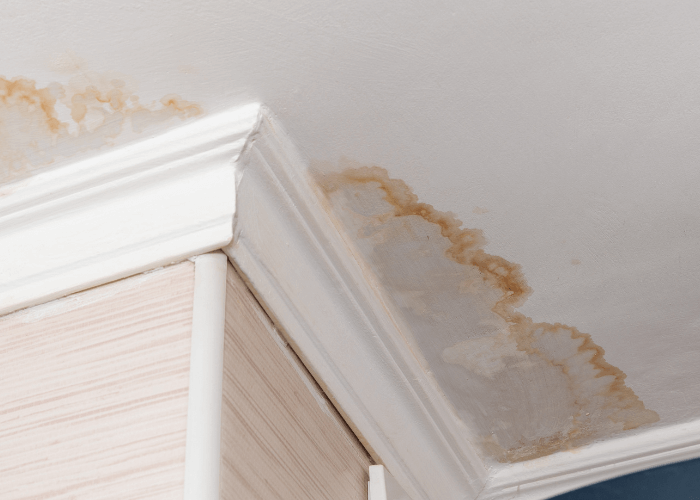Ceiling stains can detract from a room’s appearance. The stains can also cause you to wonder about their source and why they seem to be spreading. Explore five potential causes of ceiling discoloration and hidden dangers. Learn how to identify the cause and what to do about it.
What Causes Ceiling Stains?
Ceiling stain causes may include leaky roofs, plumbing issues, condensation, mold growth, or other factors. Identifying the source of the problem is preventive maintenance for your home. Don’t let the stains dampen—or damage—your rooms any longer. Discover the key culprits and learn what’s needed to stop the damage and restore your ceiling.
Five Types of Ceiling Discoloration
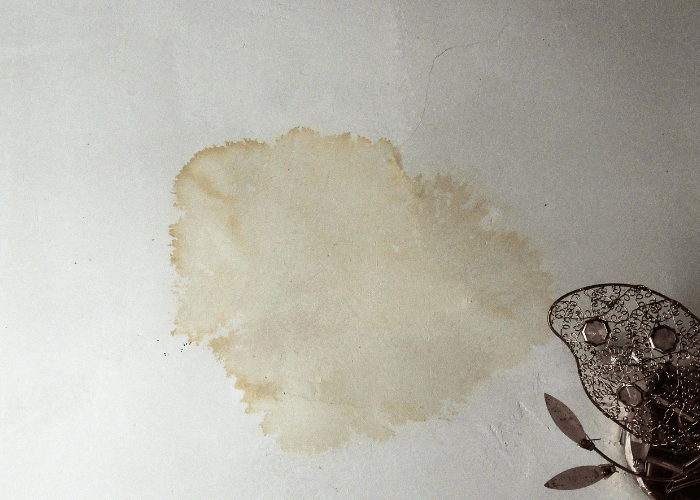
1. Water Stains
Ceiling water stains are usually brown or yellowish patches caused by water leaks. Whether a leaky roof or plumbing issue is the cause, structural damage or mold growth may follow without preventive repairs.
2. Age and Wear
Fading paint can yellow or darken an aging room ceiling. Although age-related discoloration occurs naturally, it prevents you from enjoying a fresh, vibrant space.
3. Mold and Mildew
Mold can cause ceiling stains because it thrives in moist environments. You may notice black, green, or grayish spots on your ceiling from mold or mildew. Besides being unsightly, mold creates health risks, especially for people with respiratory issues.
4. Improper Ventilation
Improper ventilation from warm, moist air can condense on the ceiling surface, leading to water stains or mold growth. Proper ventilation prevents these issues and maintains a healthy indoor environment.
5. Smoke and Soot
Smoke and soot are culprits of ceiling discoloration, especially in homes with fireplaces or tobacco smokers. Particles that settle on your ceiling leave dark stains and may emit unpleasant odors. Also, soot from fireplaces or chimneys affects your health. According to the United States Environmental Protection Agency (EPA), inhaling soot particles contributes to various health concerns, including respiratory illness and heart and lung disease.
What Can You Do About Ceiling Stains?
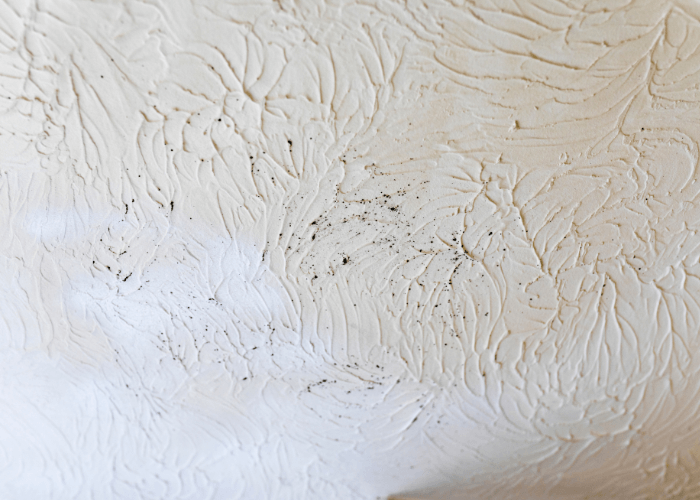
What you can do about ceiling stains in a room depends on the cause of the stains. Below are ways to prevent ceiling stains and restore the damage depending on the cause.
Water-damaged ceilings
You can reduce the risk of water damage in your ceilings and resulting stains with the following proactive steps.
- Regularly inspect your roof and plumbing for leaks. Biannual roof and plumbing inspections can identify the source of leaks. Promptly address signs of water infiltration to prevent further discoloration and damage that can lead to premature roof replacement.
- Ensure your home has enough ventilation. Use exhaust fans in high-humidity areas, such as bathrooms and kitchens, to remove excess moisture from the air.
- Keep your home well-insulated. Insulation helps regulate temperature and prevents condensation, reducing the chances of ceiling water stains and mold growth.
- Avoid smoking and soot buildup indoors. Smoke outdoors whenever possible. If you have a fireplace, ensure it is vented properly and cleaned regularly.
- Clean your ceiling regularly. Dust and dirt can accumulate, contributing to discoloration. Use a soft cloth or vacuum brush attachment to remove debris gently.
- Use mold-resistant paint or wallpaper. Consider using paint or wallpaper designed to resist mold and mildew growth.
- Consult with professionals. Seek the expertise of a licensed roofer, plumber, or HVAC tech to assess the situation and provide appropriate solutions.
Age and wear ceiling discoloration
Maintain your ceiling throughout the years with these steps:
- Use a vacuum attachment to remove dust and cobwebs.
- Check it periodically for stains, cracks, or peeling paint.
- Paint the ceiling as needed to restore its appearance.
Mold and mildew ceiling discoloration
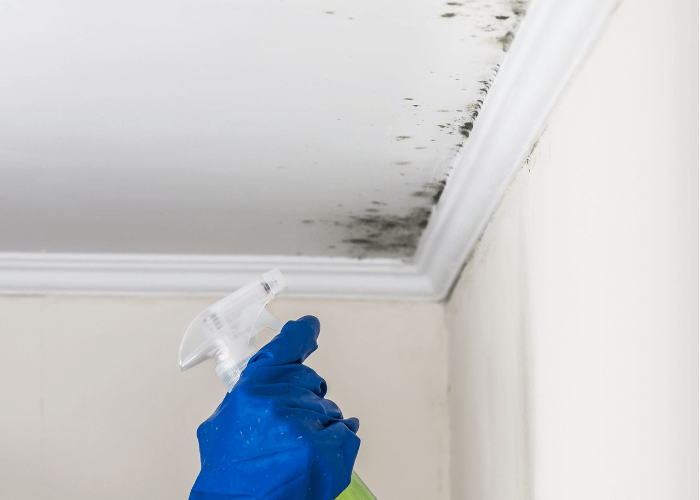
Mold and mildew in your home’s ceiling or other areas are unsightly and unhealthy. According to the EPA’s Guide to Mold, Moisture and Your Home, lingering mold exposure in your home can irritate your eyes, nose, throat, lungs, and skin. You may find that after consulting with a roofer or plumber specializing in ceiling discoloration, you may need one or more repairs for your home. Recommended services may include the following:
- Roof repair or replacement. Damaged or missing shingles, roof fixtures, or materials beneath the shingles may require roof repair or replacement.
- Plumbing services. A licensed plumber can identify and fix problems with pipe leaks to prevent further ceiling stains.
- HVAC ventilation repairs. Ceiling stains near HVAC vents reflect an insulation problem where the duct and vent attach.
- Mold remediation. Protect your health and structural damage to your home with professional mold remediation. Experts can safely remove ceiling, wall, and closet mold.
- Painting and wallpapering. A professional painter or wallpaper installer can refresh your ceiling with plaster, paint, or wallpaper after a professional has removed the cause of the stains.
Smoke- and soot-stained ceilings
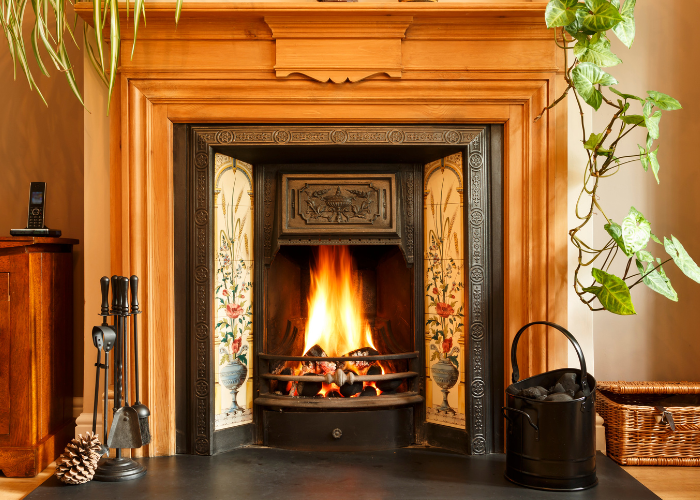
Either you or a professional can refresh your ceiling. It will require cleaning and possibly painting.
- Try cleaning the stains yourself. Sometimes, you can remove smoke and soot stains from the ceiling using a vacuum attachment to remove initial dust. Follow up with a water and dish detergent solution to gently remove stains with a soft cloth or sponge.
- Hire a professional cleaner. If smoke or soot stains are widespread or stubborn, you may need a professional cleaning or smoke remediation company.
- Control the cause of smoke or soot. Whether tobacco smoking stains or a fireplace have caused buildup on the ceiling, consider what you can do to minimize the recurrence of ceiling stains.
- Paint after cleaning. Your ceiling may need rejuvenation after cleaning or smoke remediation. Paint can restore its appearance.
Improper ventilation and ceiling discoloration
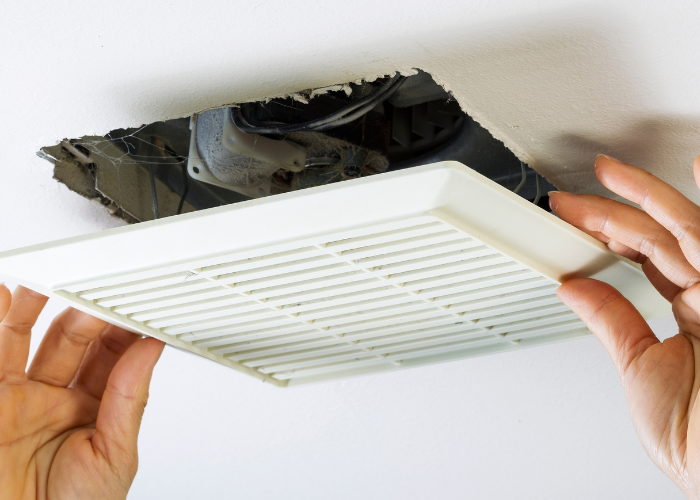
Improper ventilation can occur from humidity, HVAC, or fireplace concerns. You can take the following precautions to minimize ceiling stains:
- Air out your home periodically by opening windows.
- Use a dehumidifier or exhaust fan.
- Get yearly HVAC maintenance.
- If applicable, ensure your fireplace and chimney are functioning well.
- Ensure your attic is well-ventilated.
Conclusion
Ceiling stains may look minor, but they have a cause. Identifying the source can prevent stains from worsening and damaging your home. Moisture-caused stains can lead to ceiling cracks or collapse. Schedule regular inspections of the things that can cause ceiling discoloration, including plumbing, roofing, ventilation, and fireplaces. Uncover the hidden dangers and protect your home’s integrity.
Visit Thurston Roof’s website for details on why and how often you need a home roof inspection.

